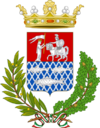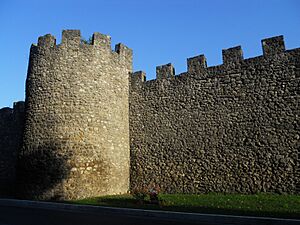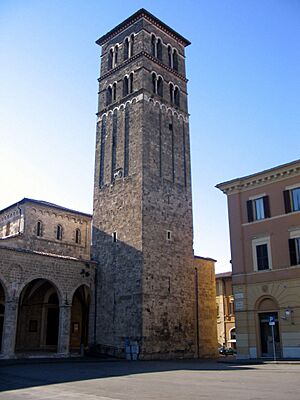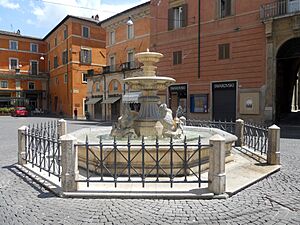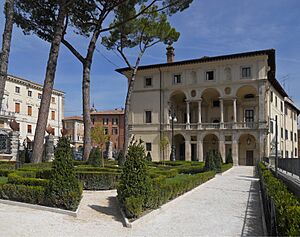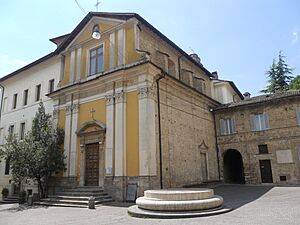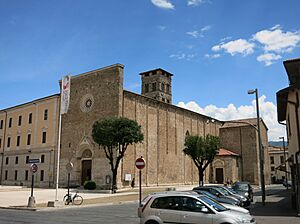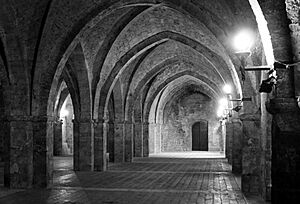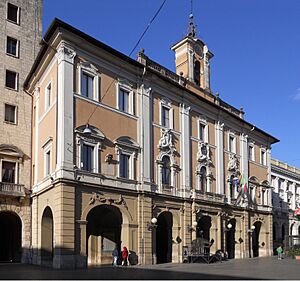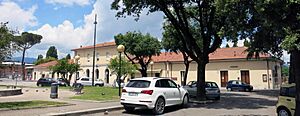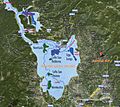Rieti facts for kids
Quick facts for kids
Rieti
|
|||
|---|---|---|---|
| Comune di Rieti | |||
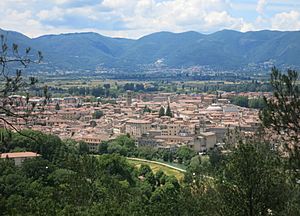
The city centre of Rieti as seen from San Mauro hill, east of the city. In the background, the Rieti valley enclosed by the Sabine mountains; in the foreground, the Velino river.
|
|||
|
|||
| Country | Italy | ||
| Region | Lazio | ||
| Province | Rieti (RI) | ||
| Frazioni | Case San Benedetto, Casette, Castelfranco, Cerchiara, Chiesa Nuova, Cupaello, Lisciano, Lugnano, Maglianello, Moggio, Piane di Poggio Fidoni, Piani di Sant'Elia, Piè di Moggio, Poggio Fidoni, Poggio Perugino, San Giovanni Reatino, Sant'Elia, Vaiano, Vazia | ||
| Area | |||
| • Total | 206.52 km2 (79.74 sq mi) | ||
| Elevation | 405 m (1,329 ft) | ||
| Population
(30 April 2008)
|
|||
| • Total | 47,745 | ||
| • Density | 231.188/km2 (598.775/sq mi) | ||
| Demonym(s) | Reatini | ||
| Time zone | UTC+1 (CET) | ||
| • Summer (DST) | UTC+2 (CEST) | ||
| Postal code |
02100
|
||
| Dialing code | 0746 | ||
| Patron saint | St. Barbara | ||
| Saint day | December 4 | ||
Rieti is a cool town in central Italy, located in a region called Lazio. About 47,700 people live there. It's the main city of the province of Rieti and is also known as the capital of the Sabina area.
The city center sits on a small hill. From here, you can see the wide Rieti valley below. This valley is surrounded by the Sabine hills and the monti Reatini, which include mount Terminillo. Long ago, this valley was a huge lake. The ancient Romans drained most of it, turning it into the rich, fertile land we see today. Only two smaller lakes, Ripasottile and Lungo, remain from the original big lake.
Contents
History of Rieti
How Rieti Began
Legend says that Rieti was founded by a goddess named Rea, which might be where the city's name comes from. It was likely started around 900-800 BC, at the beginning of the Iron Age.
Before that, the area around Rieti was probably home to different groups of people. First, there were the Umbri, then the Aborigines, and later the Sabines. The Sabines settled near the Tevere river.
Rieti in Ancient Times
Rieti, then called Reate, was a very important city for the Sabine people, even before Rome was founded. There's a famous story about how Rome started. The Romans, needing more people, took Sabine women. This led to a war between the Romans and Sabines. The battle stopped when the women, who now had families on both sides, begged them to make peace. This led to the Romans and Sabines working together.
Around 290 BC, the Romans, led by Manius Curius Dentatus, took control of the area. Rieti became a key spot in Italy's early road system. It was on the "salt track" (Via Salaria), a road that connected Rome to the Adriatic Sea. Many lands around Rieti were given to Roman citizens. The Sabines were first offered Roman citizenship without voting rights, but by 268 BC, they became full Roman citizens.
Curius Dentatus also did something amazing: he drained a large part of the ancient lake. He changed the path of the Velino river, sending its water into the Nera river. This created the beautiful Marmore Falls. The huge area that was once a lake became a very fertile plain, now known as the Rieti Valley. The Romans also planned the city with straight roads and strong walls. They built a stone bridge over the Velino river and a large bridge-like structure to bring goods from the Via Salaria right into Rieti.
Rieti is mentioned in old Roman writings because of its rich land and unique features. For example, Cicero wrote about the arguments between Rieti and another city, Terni, after the lake was drained. He also mentioned a country house owned by his friend Q. Axius in the plain.
One important Sabine family that became famous in Rome was the Gens Flavia. The Roman Emperor Titus Flavius Vespasianus, who started building the famous Colosseum, came from this family.
A famous poet and writer named Marcus Terentius Varro was born in Rieti in 116 BC. He is often called the "father of Roman knowledge" because he wrote so much.
Rieti in the Middle Ages
After the Western Roman Empire fell, Rieti was attacked by different groups like the Barbarians. But it remained an important place during the Lombard rule and later became a county capital under the Franks. It was also attacked by the Saracens in the 9th and 10th centuries and by the Norman king Roger II of Sicily in 1149.
The city was rebuilt with help from Rome. By 1198, Rieti became a free city, choosing to support the Guelph side in the conflicts of the time. It had its own leader, called a podestà.
Rieti was a favorite place for the Popes to stay. Many important historical events happened here. For example, Constance of Hauteville married Emperor Henry VI here in 1185. Charles I of Anjou was crowned King of Apulia, Sicily, and Jerusalem by Pope Nicholas IV in 1289. Also, Pope Gregory IX made St. Dominic a saint in Rieti in 1234.
A Jewish scholar and doctor named Moses ben Isaac of Rieti (1388-1467) lived here. He wrote a long poem similar to Dante's famous work.
Rieti in Later Times
When the Popes moved their main home to Avignon, Rieti was taken over by the King of Naples. Inside the city, there were also fights between different groups. In 1354, it was taken back by Cardinal Albornoz. Later, it became a feudal area controlled by the Alfani family, as part of the Papal States. More of the plain was drained in the next century, but this caused arguments with the nearby city of Terni.
Rieti was the capital of a province in the Papal States from 1816 to 1860. In 1821, a battle between Austrian forces and rebels from southern Italy happened just outside the city. After Italy became one country, Rieti was first part of the Umbria region. In 1923, it joined Lazio, and on January 2, 1927, it became a provincial capital.
Climate in Rieti
Rieti has a climate with cool winters and hot summers. It gets a good amount of rain throughout the year.
| Climate data for Rieti | |||||||||||||
|---|---|---|---|---|---|---|---|---|---|---|---|---|---|
| Month | Jan | Feb | Mar | Apr | May | Jun | Jul | Aug | Sep | Oct | Nov | Dec | Year |
| Mean daily maximum °C (°F) | 8 (46) |
10 (50) |
13 (55) |
17 (63) |
22 (72) |
25 (77) |
29 (84) |
29 (84) |
25 (77) |
20 (68) |
14 (57) |
9 (48) |
18 (65) |
| Mean daily minimum °C (°F) | 1 (34) |
0 (32) |
2 (36) |
5 (41) |
8 (46) |
11 (52) |
13 (55) |
13 (55) |
11 (52) |
7 (45) |
4 (39) |
1 (34) |
6 (43) |
| Average precipitation mm (inches) | 111 (4.4) |
110 (4.3) |
95 (3.7) |
93 (3.7) |
75 (3.0) |
70 (2.8) |
35 (1.4) |
55 (2.2) |
87 (3.4) |
106 (4.2) |
171 (6.7) |
146 (5.7) |
1,154 (45.5) |
What to See in Rieti
The old Sabine and Roman city of Rieti had many buildings, including public baths. Not much remains of these ancient structures today. During digs in the 1800s and 1900s, people found parts of a large temple, the stone floor of the main square (forum), walls from houses, and old statues. The most impressive ancient remains are the stone bridge over the Velino river and a large viaduct.
Piazza San Rufo is a special square in Rieti. People traditionally believe it's the exact center of Italy, calling it Umbilicus Italiae (Navel of Italy).
Here are some other interesting places to see:
- Rieti Cathedral: This big church started being built in 1109. It was officially opened in 1225 but was mostly rebuilt in 1639. It has a beautiful Romanesque bell tower from 1252. Inside, you'll find Baroque decorations and art from the 16th and 17th centuries. The oldest part of the church is the crypt, which was opened in 1157.
- Palazzo Vescovile (Bishops Palace or Papal Palace): This palace started being built in 1283. It has a lovely loggia (a covered walkway) and eight Renaissance-style windows from 1532. The ground floor has a large area with Gothic arches.
- Palazzo Comunale (Town Hall): This building from the 13th century was rebuilt in the 18th century. It faces Piazza Vittorio Emanuele II, which was the old Roman forum. The Town Hall has a museum with art by famous artists like Antoniazzo Romano and Antonio Canova.
- Palazzo del Governo: This palace has a grand loggia from 1596.
- Bishop's Arch: This is a bridge built by Pope Boniface VIII.
- San Pietro Martire: This church from the 13th century has fancy golden Baroque decorations.
- Palazzo Vicentini: This palace is thought to be designed by Giuliano da Sangallo the Younger.
- Walls of Rieti: These city walls were built in the early 13th century. They have cool rounded and square towers.
- Sant'Agostino: This church from the 13th century was rebuilt in the 18th century. It has a Gothic style.
- San Francesco: This church started in 1245 and was greatly changed in 1636. It has one main room. Some of its original old paintings are now in museums.
- Teatro Flavio Vespasiano: This is the city's theater and opera house, built in the late 1800s.
- Palazzo Vecchiarelli: A palace from the late Renaissance, designed by Carlo Maderno.
- Sant'Antonio al Monte: A monastery and church from the 15th century.
You can also visit the Lake Lungo and Ripasottile Natural Preserve, and Mount Terminillo.
Famous People from Rieti
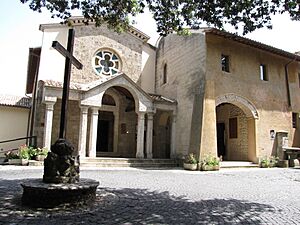
- Marcus Terentius Varro (116–27 BC): A Roman scholar and writer.
- Antonio Gherardi (1638–1702): An Italian painter, architect, and sculptor.
- Giuseppe Ottavio Pitoni (1657–1743): A famous composer.
- Giuseppe Ferrari (1840–1905): A painter.
- Elio Augusto Di Carlo (1918–1998): An Italian bird expert, historian, and doctor.
- Renzo De Felice (1929–1996): A historian who studied Fascism.
- Kobe Bryant (1978-2020): A famous NBA basketball player who grew up in Rieti.
- Willie Sojourner (1948-2005): An NBA player who played, coached, and passed away in Rieti. The city's sports arena, PalaSojourner, is named after him.
Sister Cities
Rieti has special connections with these cities around the world:
Getting Around Rieti
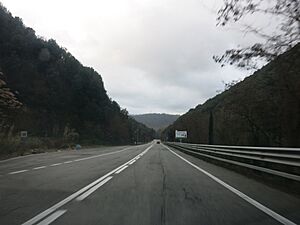
Rieti doesn't have any major highways (Autostrade) passing through it. All the roads connecting Rieti to other cities are state highways, which are usually single-lane roads.
The most important road is strada statale 4 Via Salaria. It links Rieti to Rome in the south and to Ascoli Piceno and the Adriatic Sea in the north. This road follows the path of the ancient Roman road, the Via Salaria. Other important roads include the strada statale 79 Ternana, which goes to Terni, and strada statale 17, which connects to L'Aquila.
Rieti's train station is on a regional train line that doesn't have much traffic. You can take trains to Terni and L'Aquila. There isn't a direct train line from Rieti to Rome. To get to Rome by train, you usually go to the Terni station first. You can also take a bus directly to Rome.
The Rieti Airport is mainly used by small private planes and for gliding.
Sports in Rieti
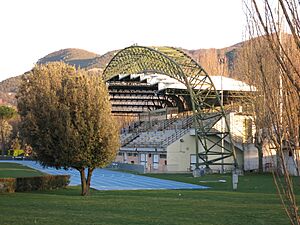
- The stadio Raul Guidobaldi in Rieti hosts the Rieti Meeting every year since 1971. This is a big international athletics event. Many world records have been set here, especially for middle-distance running. For example, Jamaican sprinter Asafa Powell set a world record in the 100 meters here in 2007. Kenyan runner David Rudisha also set a world record in the 800 meters here in 2010.
- The European Athletics Junior Championships were also held at the Stadio Raul Guidobaldi in 2013.
- Rieti is well-known for its strong athletics community. There's about one athlete for every forty people! The main athletics team is Atletica Studentesca Andrea Milardi. Many Italian athletes who became part of the national team grew up here, like Andrew Howe and Patrizia Spuri.
- Rieti also had an important basketball team called AMG Sebastiani Basket. They played in the PalaSojourner arena and won a European cup in 1979-80. Famous players like Willie Sojourner and Joe Bryant played for this team. Joe Bryant's son, Kobe Bryant, who also became a famous NBA player, went to school in Rieti and spoke fluent Italian. After the original team ended, new teams like Nuova AMG Sebastiani were formed and played in Italy's top basketball league for a while.
- The biggest football (soccer) club in Rieti is FC Rieti, which plays at the Stadio Centro d'Italia – Manlio Scopigno. There's also a Futsal (indoor soccer) team called Real Rieti Calcio a 5 that plays in Italy's top league.
- Rieti has a 9-hole golf course called the "Centre of Italy" golf club.
Images for kids
See also
 In Spanish: Rieti para niños
In Spanish: Rieti para niños



